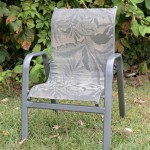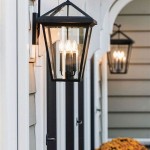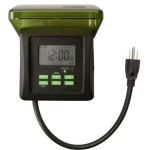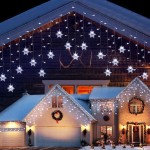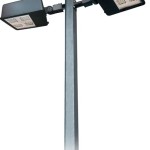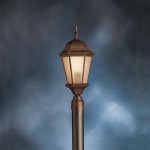Best Ways to Hang Outdoor Lights On Brick Wall
Creating an inviting outdoor ambiance often involves strategically placed lighting. Brick walls present a unique challenge for hanging lights compared to surfaces like wood or siding. The textured, solid nature of brick requires careful selection of methods and materials to ensure secure and aesthetically pleasing results without causing damage to the brickwork.
Several factors influence the optimal method for hanging outdoor lights on brick. These include the type of lights (string lights, individual fixtures, etc.), the desired permanence of the installation, the condition of the brick, and personal preferences regarding aesthetics and ease of installation. Each technique possesses its own advantages and disadvantages, making it crucial to consider these factors prior to commencing the project.
Adhesive Clips and Hooks
Adhesive clips and hooks provide a relatively simple and non-invasive approach to hanging outdoor lights on brick. These products utilize strong adhesives designed to adhere to porous surfaces. They are typically available in various sizes and weight capacities, allowing for selection based on the type and length of lights being installed.
The primary advantage of adhesive clips and hooks lies in their ease of installation. The process generally involves cleaning the brick surface, peeling off the backing from the adhesive, and firmly pressing the clip or hook onto the desired location. No drilling or hammering is required, minimizing the risk of damage to the brick.
However, adhesive-based methods possess certain limitations. The adhesive bond can be affected by factors such as temperature fluctuations, moisture, and surface contaminants. Over time, the adhesive may weaken, leading to the lights detaching from the wall. Furthermore, removing adhesive clips and hooks can sometimes leave behind residue or even damage the brick surface, particularly if the adhesive is excessively strong or improperly removed.
When using adhesive clips, it is essential to thoroughly clean the brick surface to remove any dirt, dust, or debris that could interfere with the adhesive bond. Isopropyl alcohol can be used to further degrease the surface. Choosing clips and hooks specifically designed for outdoor use ensures that they are formulated to withstand the elements. Distributing the weight of the lights evenly and avoiding overloading individual clips or hooks maximizes the lifespan of the installation. Regularly inspecting the clips and hooks for signs of loosening or deterioration is recommended, and replacements should be made as needed.
Another consideration is the compatibility of the adhesive with the brick type. Some bricks are more porous than others, and certain adhesives may not adhere effectively to all brick surfaces. Testing a small, inconspicuous area with the adhesive prior to full-scale installation is advisable.
Brick Clips
Brick clips, also known as brick hangers or brick fasteners, offer a more secure and semi-permanent solution for hanging outdoor lights on brick. These clips are designed to grip onto the edge of the brick without requiring any drilling or permanent alterations. They typically feature a spring-loaded or adjustable mechanism that allows them to be securely attached to the brick.
The main benefit of brick clips is their ability to provide a strong and reliable hold without damaging the brick. They are relatively easy to install and remove, making them a versatile option for temporary or seasonal lighting displays. Brick clips are available in various sizes and styles to accommodate different brick thicknesses and light types.
Despite their advantages, brick clips do have some potential drawbacks. They may not be suitable for all brick types or wall configurations. If the brick is excessively uneven or damaged, the clips may not be able to grip properly. Additionally, the weight capacity of brick clips is limited, so they may not be appropriate for hanging heavy or bulky lights.
When choosing brick clips, it is crucial to select the correct size and type for the specific brick dimensions. Measuring the thickness of the brick accurately is essential to ensure a proper fit. Ensure that the clips are made of durable, weather-resistant materials to withstand outdoor conditions. Spacing the clips appropriately along the length of the lights is important to distribute the weight evenly and prevent sagging or detachment. Periodically inspecting the clips to ensure they remain securely attached is recommended.
Consider the aesthetic impact of the brick clips. While some are designed to be discreet, others may be more visible. Choose a style that complements the overall look of the outdoor space. Avoid using excessive force when attaching or removing the clips, as this could damage the brick or the clips themselves.
Mortar Joint Anchors
Mortar joint anchors provide a more permanent and robust method for hanging outdoor lights on brick walls. These anchors are inserted into the mortar joints between the bricks, providing a secure attachment point for hooks, screws, or other fasteners. This method offers a high load-bearing capacity, making it suitable for hanging heavier or more complex lighting fixtures.
The primary advantage of mortar joint anchors is their strength and durability. Once properly installed, they can withstand significant weight and resist the effects of weather and time. This makes them a reliable choice for long-term outdoor lighting installations.
However, installing mortar joint anchors requires more skill and effort than adhesive clips or brick clips. The process typically involves drilling into the mortar joint, inserting the anchor, and tightening it to create a secure hold. It is crucial to use the correct drill bit size and to avoid damaging the surrounding brick. Improper installation can weaken the mortar joint and potentially compromise the structural integrity of the wall.
Selecting the appropriate type of mortar joint anchor is crucial. There are several types available, including screw-in anchors, expansion anchors, and chemical anchors. The choice depends on the type of lights being installed, the condition of the mortar joint, and the desired level of permanence. Using a high-quality, weather-resistant anchor is essential to prevent corrosion and ensure long-term performance. Thoroughly cleaning the mortar joint before installation is important to remove any dirt or debris that could interfere with the anchor's grip.
When drilling into the mortar joint, exercise caution to avoid damaging the surrounding bricks. Using a slow speed and applying gentle pressure can help prevent chipping or cracking. After inserting the anchor, make sure it is securely tightened according to the manufacturer's instructions. Regularly inspecting the anchors for signs of loosening or corrosion is recommended, and replacements should be made as needed. This method, while durable, does require some minor damage to the mortar, and patching may be required upon removal.
Consider the long-term implications of using mortar joint anchors. While they provide a secure attachment point, they are more difficult to remove than adhesive clips or brick clips. If the lights are to be removed in the future, the anchors may need to be cut off or filled with mortar to restore the appearance of the wall. Therefore, it is important to carefully consider the permanence of the installation before choosing this method.
In summary, selecting the best method for hanging outdoor lights on a brick wall involves weighing the pros and cons of each approach. Adhesive clips offer simplicity but may lack long-term durability. Brick clips provide a secure grip without drilling but may not be suitable for all brick types. Mortar joint anchors offer a robust and permanent solution but require more skill and effort to install. Careful consideration of these factors will allow for a successful and aesthetically pleasing outdoor lighting installation.
Regardless of the method chosen, safety precautions should always be observed when working with electricity and heights. Ensure that all electrical connections are properly insulated and protected from the elements. Use a sturdy ladder or scaffolding to reach high areas, and avoid working in wet or windy conditions. By following these guidelines and selecting the appropriate materials and techniques, outdoor lights can be safely and effectively hung on brick walls, transforming the outdoor space into an inviting and festive environment.

How To Hang Fairy Lights Outside Easy String Guide

How To Hang Outdoor String Lights 5 Ways Taskrabbit Blog

19 Things You Should Put On Your Front Porch Patio Lighting House With Exterior

26 Times Twinkle Lights Made Everything Better Backyard Lighting Patio

How To Hang Outdoor Lights Ideas Advice Diy At B Q

How To Hang Outdoor Lights Robert Dyas

How To Hang Outdoor String Lights Ideas True Value

How To Hang Lights On Brick

Spring Has Sprung Get Your Outdoor Lighting Sorted Fat S Vintage

How To Hang Outdoor String Lights The Home Depot
